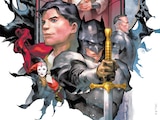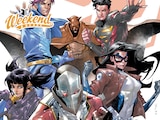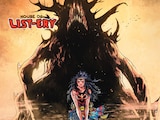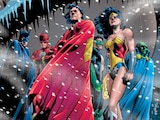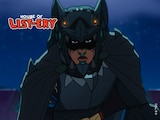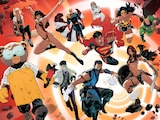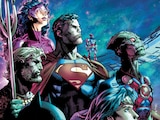Dreams are an interesting thing. They can motivate us to do things we never thought were possible. They can give us hope during times of despair, and they can help you improve your life. Some dreams are fleeting, with all memories of them gone once you awake. Other dreams stay with you for decades to come and push you to accomplish greatness. Just look at Neil Gaiman. The celebrated author had a dream of bringing his critically acclaimed comic The Sandman to life as a movie or a television series. Thanks to Netflix and Warner Bros. Television, that dream is now a reality.
If you’re a longtime fan of The Sandman who is amazed that it was adapted so faithfully, you’re not alone. Sandman creator and co-executive producer Neil Gaiman is just as surprised as you are—surprising considering he helped make the show.
“Something that almost shouldn’t have happened, because the odds against this happening are enormous,” he muses. “For thirty-odd years, people were trying to make Sandman films, they were trying to take 3,000 pages of Sandman and somehow condense it successfully into two hours of cinema and it never worked.”

If you’re enjoying The Sandman, then you should probably be grateful for Good Omens, another television adaptation of Gaiman’s work. The celebrated author revealed that if it wasn’t for the success of that production, we probably never would have seen The Sandman come to Netflix.
“It took me having showrun Good Omens,” Gaiman shares. “And everybody suddenly going, ‘Oh, he's not just the writer, who is a weird thing that we need to keep as far away from this as possible, he's a showrunner and he made this adaptation, he understands this stuff, and why don't we bring him in?’ And then it took finding Allan (Heinberg), it took this golden era of TV streaming, it took something the size of Netflix to say, yes, here is the CGI budget that you're going to need to make this.”
You have co-executive producer Allan Heinberg to thank for the faithfulness of Netflix’s adaptation. During production, Heinberg made sure the comic was always on hand as a guide.
“We always had the book with us,” he explains. “Everybody had an iPad with the book all the time, but we weren't slaves to it. We were inspired and elevated by it.” Heinberg says.

In fact, Gaiman soon learned that almost everyone on set was a fan of the comic book.
“What was magic about this whole thing was that you had a show being made by Sandman fans, and being crewed by Sandman fans, and being staffed by Sandman fans,” he shares. “A few weeks ago, I was in London walking through a street market on a chilly Sunday morning, and all of a sudden one of the props people who had been on Sandman just came running over, and said, ‘I just have to tell you, I was doing props on Sandman, and I'm such a fan, and my brother is such a fan, and it's the coolest job I've ever done in my whole life, and I don't know if I'll ever do anything that cool again.’ That makes me so happy.”
Although the comic served as the blueprint for the show, it was important to recognize what would work onscreen, what wouldn’t, and how the story could be augmented.
“Because everybody was steeped in the book, we made all of our choices according to what would happen if we did what's here, and then if it didn't work, what can we do to augment it and make sure that the same story is being told and that the book is being evoked,” Heinberg reveals. “Because even if we're not slavishly doing it panel by panel, I really wanted the audience, if they'd read the books, to feel like this is the Sandman I remember, and then to go back and reread it and see why we did what it is that we did, and what we added and why we added it.”

Bringing The Sandman to life also meant finding the perfect cast. Once again, love and reverence for the source material helped bring all that together.
“We'd seen hundreds and hundreds of people before we got to Kirby,” Gaiman says, referring to Kirby Howell-Baptiste, who plays Death. “She got the part because she could say the lines right. It was only today talking to her that I twigged that she said the lines right because she'd been a Sandman fan and she loved Death. She knew what Death sounded like and how those lines should be delivered, so she delivered them as Death rather than being an actress getting a bunch of sides and going, ‘Oh, this is weird kind of dialogue. Okay, I'll say it.’ I think for all of us, that was the most important thing of all.”
This love of the source material extended to the rest of the cast. “Those were our people,” Gaiman says. “You talk to Gwendoline (Christie), you talk to Tom (Sturridge), you talk to these guys, and as far as they're concerned, they're doing something that is—I will use the word kind of advisedly, but you can make fun of me if you like—sacred. They're doing something kind of holy. It's big, and it's important, and it's not to be taken lightly. And that knowledge is what they bring with them.”

The fifth episode, which adapted the infamous story “24 Hours,” was something the showrunners were determined to get right.
“The diner episode was the most challenging because of the way the comic book itself is structured and built,” Heinberg admits. “Once I sort of figured out how I wanted to do it, it was the most rewarding experience too. I think that was the most radical departure from the structure of the comics, but also the most rewarding and Jamie Childs did an amazing job directing it. It ended up being my favorite.”
Of course, there are certain advantages to having the author of the original comic as a co-showrunner.
“I could get a message from Allen asking me something about the diner,” Gaiman says. “And I could go to (“24 Hours” artist) Mike Dringenberg and say, ‘Hey, when you did the diner, was it based on a real place?’ And he was like, ‘Oh yeah, it was this diner that was in Salt Lake City, and I went there and I drew it all down. I sketched it, and here is a link to photos that people have put online, and here's their menu.’ We took the menu of the diner that Mike Dringenberg drew ‘24 Hours’ in. Nobody knows, and nobody cares except us, but that's the menu that's in the diner, and that's the menu design.”

Heinberg, undoubtedly speaking for The Sandman’s legions of fans, was grateful that the team was able to honor the original comic with that level of accuracy.
“That was paramount, to me and to Neil, and to every department head and every actor,” he confirms. “That was our guiding.”
The Sandman has been the subject of numerous attempts at adaptation prior to the series you can now stream today. All of them failed, and in some ways, Gaiman is thankful for that.
“It all came together,” he says. “There is no part of me that wishes we could have made this in 1997 because we couldn't have made this in 1997. But we could make it now, and we have, and we are so lucky.”
The Sandman, starring Tom Sturridge as Morpheus, is now streaming on Netflix. For more dreams, fables and recollections, visit our official Sandman TV page.

